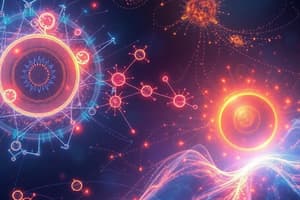Podcast
Questions and Answers
Why are Zn, Cd, Hg, and Cn not considered transition elements?
Why are Zn, Cd, Hg, and Cn not considered transition elements?
- They have a high electronegativity.
- They have completely filled d-orbitals in their ground state. (correct)
- They exhibit variable oxidation states.
- They form colored ions.
What is the electronic configuration of the outer orbitals of scandium (Sc) in its ground state?
What is the electronic configuration of the outer orbitals of scandium (Sc) in its ground state?
- 3d14s2 (correct)
- 3d24s1
- 3d104s2
- 4d15s2
Which of the following is NOT a characteristic property of transition elements?
Which of the following is NOT a characteristic property of transition elements?
- Paramagnetism
- Formation of complex ions
- Variable oxidation states
- High melting points (correct)
Why do transition elements exhibit variable oxidation states?
Why do transition elements exhibit variable oxidation states?
Which of the following statements accurately describes the similarity of properties of transition elements?
Which of the following statements accurately describes the similarity of properties of transition elements?
What is the general electronic configuration of transition metals?
What is the general electronic configuration of transition metals?
Why do many transition metals exhibit a large range of oxidation states?
Why do many transition metals exhibit a large range of oxidation states?
Which of the following statements about the electronic configurations of transition metals is incorrect?
Which of the following statements about the electronic configurations of transition metals is incorrect?
Which element's electronic configuration deviates from the general rule for transition metals, due to the stability of half-filled orbitals?
Which element's electronic configuration deviates from the general rule for transition metals, due to the stability of half-filled orbitals?
Which of the following elements is not part of the transition metal series?
Which of the following elements is not part of the transition metal series?
Flashcards
Transition Elements
Transition Elements
D-block elements in the periodic table, including 3d, 4d, 5d, and 6d series.
Electronic Configuration
Electronic Configuration
Arrangement of electrons in an atom's orbitals, noted as (n-1)d1-10 ns1-2 for transition metals.
Oxidation States
Oxidation States
Valencies that transition metals can exhibit, due to loss of electrons from (n-1)d and ns orbitals.
Complex Formation
Complex Formation
Signup and view all the flashcards
Stability of Orbitals
Stability of Orbitals
Signup and view all the flashcards
Electronic Configuration (Zn, Cd, Hg, Cn)
Electronic Configuration (Zn, Cd, Hg, Cn)
Signup and view all the flashcards
Scandium as a Transition Element
Scandium as a Transition Element
Signup and view all the flashcards
Properties of Transition Elements
Properties of Transition Elements
Signup and view all the flashcards
Variable Oxidation States
Variable Oxidation States
Signup and view all the flashcards




